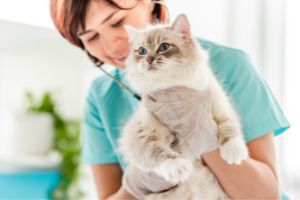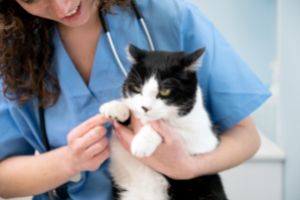Cats are glorious creatures—motion optimized, aesthetically pleasing, low maintenance, warm, fuzzy, furry, cute, and they purr. Could you ask for a more perfect pet? As feline-favoring veterinarians, cats have only one major design flaw—they were designed with a poorly functioning elimination system. Specifically, their kidneys are weak, they don't drink enough water, and the cat's urinary tract frequently suffers from disease. The kidney issue is a discussion for another day. For now, let's talk about Feline Urologic Syndrome (FUS), aka Feline Lower Urinary Tract Disease (FLUTD), aka Feline Idiopathic Cystitis or Feline Interstitial Cystitis. It's amazing what your cat's urine can tell you about their health!

Cat Urinary Tract Disease is the Curse of a Veterinarian's Existence
Cat urinary tract disease is a prevalent issue. Veterinarians will tell you that 90% (or at least what feels like 90%!) of sick cat visits can be summarized in one line: "The cat just peed on my Persian rug/pile of laundry/fancy purse/kid's backpack/bed sheets, and I'm seriously considering making her an outside cat or euthanizing her or sending her back to the shelter if you don't fix this right now!"
And we get it. Nothing stinks like cat pee.
The most challenging thing about urinary issues in cats is that they:
– Occur in otherwise young, healthy patients
– Have no definable cause
– Have no reliable prevention
– Have no known cure
– Be potentially lethal
– Cause thousands of dollars in property damage
– Cause everyone around the patient emotional stress
– Fill up overcrowded Humane Society buildings
We could go on and on, but the bottom line is that we feel your pain. Call it what you want; cats who pee on stuff are no fun for anyone. Inappropriate urination is the #1 cause of cat surrender to animal shelters.
Cat Urinary Tract Illnesses Are Widespread
It has been estimated that at any given time, 1.5% of all cats in the US suffer from a feline urinary tract disorder. If we conservatively say there are at least 60 million American homes with cats, that means that right now, somewhere, 900,000 American cats are straining to pee on a bathroom rug. So it's not just your cat; the neighbor's cat is doing it too. If you have a cat, chances are, at some point, you've had to deal with cat pee in places it's not supposed to go. Our temptation is to label this behavior with human traits and say the cat is either angry at us, frustrated, vengeful, lazy, or just mean. Naturally, cats aren't capable of any of these emotions.
Rule out Medical Causes of Inappropriate Cat Urination FIRST
PRO TIP: Fewer than 2% of Inappropriately Urinating Cats have a Bladder Infection
Our physicians have trained humans to think that if something is bothering one's bladder, it must be an infection. But in cats, that's simply not true. If we were to look at a population of 100 cats that presented with medical bladder problems, 2% of them would have a bacterial UTI. And, despite what the pet food industry wants us to believe, only 20% have struvite or oxalate crystals in the bladder, causing irritation (which can often be managed with diet). That means that 78% of all cats that presented with symptoms related to the cat urinary tract or inappropriate urination have NO infection, NO crystals, NO cancer, NOTHING. Just a little bit of blood, really sad and frustrated owners, and a trail of destruction at home. Cat bladders just get grumpy sometimes, for no darn good reason at all.
Now, that's not to say we won't send home antibiotics and/or a prescription diet for most cases of cat urinary tract disease because we certainly will. The point is that no one should expect antibiotics, diet, or anything else (including natural remedies, which, BTW, never work) to solve the problem immediately, nor can one expect the issue won't recur because there's a good chance it might. Rational expectations are the key to success when it comes to the illness of the cat urinary tract.
So what causes the cat bladder wall to suddenly bleed and shed cells and irritate the cat to the point they have to pee on your stuff? Nobody knows. They just do that. And why, when the cat urinary tract and bladder are irritated, does that irritation force the cat to pee outside of the litterbox? Why can't they strain INSIDE the litterbox?! We wish we knew. Cats like to share their suffering with others when they feel bladder pain. Cats are funny like that.
The bottom line of this discussion is simple: if something is bothering your kitty, take them to the veterinarian. But when you do, keep an open mind. Veterinarians s are not just antibiotic-dispensing machines—we have other tricks up our collective veterinarian sleeves, and the problem may not be an infection. The cat's urinary tract is a mysterious beast and deserves our respect and patience to treat.
Your veterinarian will likely rule out medical causes of bladder irritation with a series of routine tests:
- A complete physical examination
- A urinalysis
- A bacterial culture of the urine
- X-rays of the bladder
We'll conduct these tests to rule out the medical causes of inappropriate urination before we make the dreaded diagnosis of a behavioral issue.
The Dreaded "Behavioral" Diagnosis
Cats do not pee on your stuff because they are mad at you. Cats are incapable of anger, jealousy, or any other myriad emotions we swear they feel.
A cat that urinates on your stuff is anxious about something, pure and simple. One must think like a cat to get to the source of the anxiety. Be the cat. See the world through the cat's eyes.

Treating a Cat with Behavioral Inappropriate Urination
Why do cats pee when they're anxious? We're not sure why, but we know that treating these cats somehow makes your cat's life less stressful. Sometimes that means giving the cat a cleaner, bigger litterbox. Sometimes it means more love and attention, and other times it means Prozac.
Before we get into drugs, there are a few universal rules about inappropriate urination in cats that you should keep in mind:
Cats value independence. In multiple cat households, each cat will often choose a preferred box, mark it with their urine, and refuse to use each other's boxes. Buy one more box than the number of cats in your home.
Cats value safety. Every cat in your house should have safe access to a litterbox without interference from housemates because nothing stresses out a cat more than another cat. Sometimes cats will ambush another cat when they step into or out of the litter box. Put another way: If Cat A is standing in the only doorway to the litterbox room, it makes sense that Cat B might sometimes pee on your bathroom rug rather than risk a fight with Cat A. Does your box have a cover? Perhaps having that cover makes your cat feel trapped. Watch your cats. Do they "lie in wait" for another cat to go in and then pounce? If you can, put each litter box in a separate room and/or on different floors.
Cats value privacy. Put those litterboxes in quiet, stress-free places. Sometimes that means your bathroom; sometimes, it's in a closet. Rarely is it beside the washing machine or furnace or other loud appliances. Cats value their personal space. It's been said that in a home with five cats, the probability of having to deal with inappropriate urination by one of those cats approaches 100%.
That's all you need to know about inter-cat communication. Now let's talk about personal preference:
Cats value cleanliness. Your cat spends most of their waking hours cleaning themselves. Do you think they want to walk through last week’s pee residue on the bottom of their litterbox? Or worse yet, a housemate's pee residue? Eww! Too few litter boxes can get soiled very quickly, and a fastidious cat may not want to step inside. Scoop every litterbox at least twice daily. Thoroughly empty, scrub out the boxes, and refill with clean litter at least weekly. Cleaning a litterbox is a pain, but it's a sure sight easier than cleaning cat pee off your stuff.
Cats value consistency. Most cats will develop a preference for the feel of their litter, and 99% of them will prefer clumping clay litter. Change your cat's brand or type of litter at your own peril.
Cats value their sense of smell. Some cats will refuse to use heavily perfumed cat litter. Litter labeled as "multi-cat household" simply has more perfume added to it; if your cat is having a urine problem, try unscented clumping clay litter instead.
Cats value pheromone signals. If something has changed in your home – position of furniture, new people, old people leaving – consider adding Feliway pheromone to the mix. Feliway is a concoction of the pheromones cats rub on you with their face, which they do to mark familiar and safe territory. Feliway can convince some cats that new things are as safe as old things.
A Note on Spraying
Cats that back their butt up to a vertical surface, wiggle their tails, and pee sideways are marking the object. Neutering often helps if done early enough in life, though sometimes cats will get in the habit of urine marking, and you'll have a more challenging time breaking them of this habit. Consult an animal behaviorist for help. Spraying is not the same as inappropriate urination. Spraying is a marking behavior, while inappropriate urination is an anxiety behavior.
Again, the best thing to do as soon as you recognize an issue with your cat's urination habits is to call us right away so that we can get to the bottom of what's going on and get your cat on the path to wellness—while saving your sanity (and bathroom rugs)!

